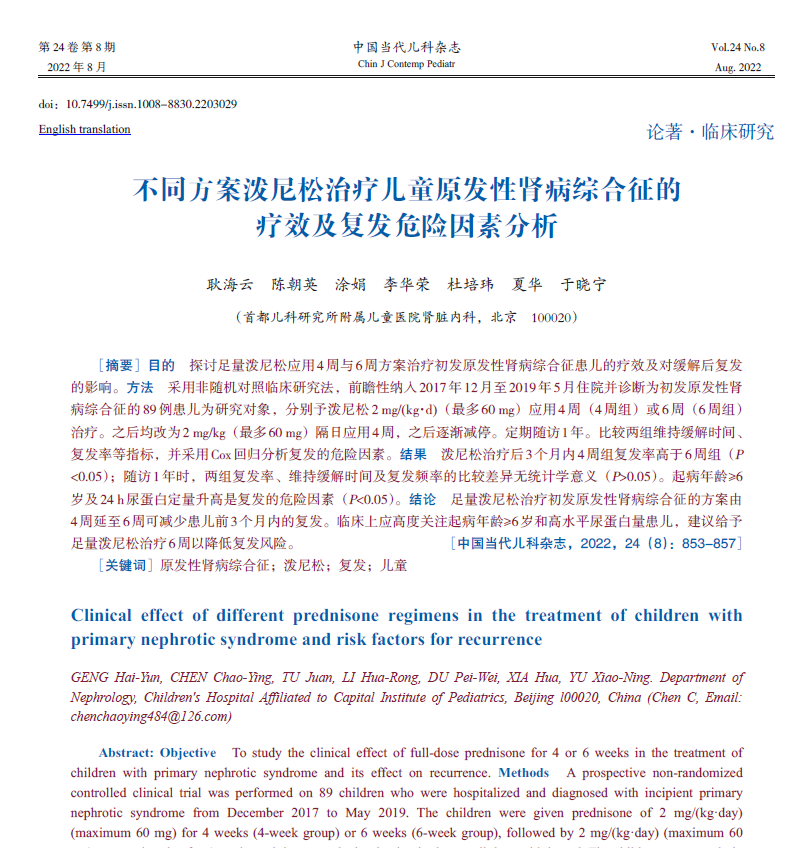目的 探讨足量泼尼松应用4周与6周方案治疗初发原发性肾病综合征患儿的疗效及对缓解后复发的影响。 方法 采用非随机对照临床研究法,前瞻性纳入2017年12月至2019年5月住院并诊断为初发原发性肾病综合征的89例患儿为研究对象,分别予泼尼松2 mg/(kg·d)(最多60 mg)应用4周(4周组)或6周(6周组)治疗。之后均改为2 mg/kg(最多60 mg)隔日应用4周,之后逐渐减停。定期随访1年。比较两组维持缓解时间、复发率等指标,并采用Cox回归分析复发的危险因素。 结果 泼尼松治疗后3个月内4周组复发率高于6周组(P<0.05);随访1年时,两组复发率、维持缓解时间及复发频率的比较差异无统计学意义(P>0.05)。起病年龄≥6岁及24 h尿蛋白定量升高是复发的危险因素(P<0.05)。 结论 足量泼尼松治疗初发原发性肾病综合征的方案由4周延至6周可减少患儿前3个月内的复发。临床上应高度关注起病年龄≥6岁和高水平尿蛋白量患儿,建议给予足量泼尼松治疗6周以降低复发风险。
Abstract
Objective To study the clinical effect of full-dose prednisone for 4 or 6 weeks in the treatment of children with primary nephrotic syndrome and its effect on recurrence. Methods A prospective non-randomized controlled clinical trial was performed on 89 children who were hospitalized and diagnosed with incipient primary nephrotic syndrome from December 2017 to May 2019. The children were given prednisone of 2 mg/(kg·day) (maximum 60 mg) for 4 weeks (4-week group) or 6 weeks (6-week group), followed by 2 mg/(kg·day) (maximum 60 mg) every other day for 4 weeks and then a gradual reduction in dose until drug withdrawal. The children were regularly followed up for 1 year. The two groups were compared in terms of the indices including remission maintenance time and recurrence rate. A Cox regression analysis was used to assess the risk factors for recurrence. Results Within 3 months after prednisone treatment, the 4-week group had a significantly higher recurrence rate than the 6-week group (P<0.05). After 1-year of follow-up, there was no significant difference between the two groups in the recurrence rate, remission maintenance time, and recurrence frequency (P>0.05). The risk of recurrence increased in children with an onset age of ≥6 years or increased 24-hour urinary protein (P<0.05). Conclusions For the treatment of incipient primary nephrotic syndrome, full-dose prednisone regimen extended from 4 weeks to 6 weeks can reduce recurrence within 3 months. The children with an onset age of ≥6 years or a high level of urinary protein should be taken seriously in clinical practice, and full-dose prednisone treatment for 6 weeks is recommended to reduce the risk of recurrence.
关键词
原发性肾病综合征 /
泼尼松 /
复发 /
儿童
Key words
Primary nephrotic syndrome /
Prednisone /
Recurrence /
Child
{{custom_sec.title}}
{{custom_sec.title}}
{{custom_sec.content}}
参考文献
1 Eddy AA, Symons JM. Nephrotic syndrome in childhood[J]. Lancet, 2003, 362(9384): 629-639. PMID: 12944064. DOI: 10.1016/S0140-6736(03)14184-0.
2 Trompeter RS, Lloyd BW, Hicks J, et al. Long-term outcome for children with minimal-change nephrotic syndrome[J]. Lancet, 1985, 1(8425): 368-370. PMID: 2857421. DOI: 10.1016/s0140-6736(85)91387-x.
3 全国儿童常见肾脏病诊治现状调研工作组. 我国儿童激素敏感、复发/依赖肾病综合征诊疗现状的多中心研究[J]. 中华儿科杂志, 2014, 52(3): 194-200. PMID: 24824389. DOI: 10.3760/cma.j.issn.0578-1310.2014.03.007.
4 Abramowicz M, Barnett HL, Edelmann CM, et al. Controlled trial of azathioprine in children with nephrotic syndrome. A report for the international study of kidney disease in children[J]. Lancet, 1970, 1(7654): 959-961. PMID: 4191931. DOI: 10.1016/s0140-6736(70)91093-7.
5 Short versus standard prednisone therapy for initial treatment of idiopathic nephrotic syndrome in children. Arbeitsgemeinschaft für P?diatrische Nephrologie[J]. Lancet, 1988, 1(8582): 380-383. PMID: 2893190.
6 Kidney Disease: Improving Global Outcomes (KDIGO) Glomerulonephritis Work Group. KDIGO clinical practice guideline for glomerulonephritis[J]. Kidney Int Suppl (2011), 2012, 2(2): 139-274. DOI: 10.1038/kisup.2012.9.
7 中华医学会儿科学分会肾脏学组. 儿童激素敏感、复发/依赖肾病综合征诊治循证指南(2016)[J]. 中华儿科杂志, 2017, 55(10): 729-734. PMID: 29050108. DOI: 10.3760/cma.j.issn.0578-1310.2017.10.003.
8 李凤鸣. 中华眼科学[M]. 2版. 北京: 人民卫生出版社, 2005: 1473.
9 Norero C, Delucchi A, Lagos E, et al. Initial therapy of primary nephrotic syndrome in children: evaluation in a period of 18 months of two prednisone treatment schedules. Chilean Co-operative Group of Study of Nephrotic Syndrome in Children[J]. Rev Med Chil, 1996, 124(5): 567-572. PMID: 9035508.
10 Mishra K, Kanwal SK, Sajjan SV, et al. Predictors of poor outcome in children with steroid sensitive nephrotic syndrome[J]. Nefrologia (Engl Ed), 2018, 38(4): 420-424. PMID: 29429831. DOI: 10.1016/j.nefroe.2018.06.009.
11 Mishra OP, Abhinay A, Mishra RN, et al. Can we predict relapses in children with idiopathic steroid-sensitive nephrotic syndrome?[J]. J Trop Pediatr, 2013, 59(5): 343-349. PMID: 23619602. DOI: 10.1093/tropej/fmt029.
12 Kikunaga K, Ishikura K, Terano C, et al. High incidence of idiopathic nephrotic syndrome in East Asian children: a nationwide survey in Japan (JP-SHINE study)[J]. Clin Exp Nephrol, 2017, 21(4): 651-657. PMID: 27590892. DOI: 10.1007/s10157-016-1319-z.
13 Webb NJA, Woolley RL, Lambe T, et al. Long term tapering versus standard prednisolone treatment for first episode of childhood nephrotic syndrome: phase III randomised controlled trial and economic evaluation[J]. BMJ, 2019, 365: l1800. PMID: 31335316. PMCID: PMC6531851. DOI: 10.1136/bmj.l1800.
14 Nakanishi K, Iijima K, Ishikura K, et al. Two-year outcome of the ISKDC regimen and frequent-relapsing risk in children with idiopathic nephrotic syndrome[J]. Clin J Am Soc Nephrol, 2013, 8(5): 756-762. PMID: 23371961. PMCID: PMC3641620. DOI: 10.2215/CJN.09010912.
15 Abdel-Hafez MA, Abou-El-Hana NM, Erfan AA, et al. Predictive risk factors of steroid dependent nephrotic syndrome in children[J]. J Nephropathol, 2017, 6(3): 180-186. PMID: 28975099. PMCID: PMC5607981. DOI: 10.15171/jnp.2017.31.
16 张碧丽, 张瑄, 王文红, 等. 原发性肾病综合征患儿复发的危险因素分析[J]. 临床儿科杂志, 2011, 29(8): 746-748. DOI: 10.3969/j.issn.1000-3606.2011.08.013.
 PDF(539 KB)
PDF(539 KB)


 PDF(539 KB)
PDF(539 KB)
 PDF(539 KB)
PDF(539 KB)
